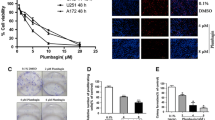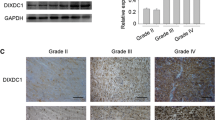Abstract
PinX1 induces apoptosis and suppresses cell proliferation in some cancer cells, and the expression of PinX1 is frequently decreased in some cancer and negatively associated with metastasis and prognosis. However, the precise roles of PinX1 in gliomas have not been studied. In this study, we found that PinX1 obviously reduced the gliomas cell proliferation through regulating the expressions of cell cycle-relative molecules to arrest cell at G1 phase and down-regulating the expression of component telomerase reverse transcriptase (hTERT in human), which is the hardcore of telomerase. Moreover, PinX1 could suppress the abilities of gliomas cell wound healing, migration and invasion via suppressing MMP-2 expression and increasing TIMP-2 expression. In conclusion, our results suggested that PinX1 may be a potential suppressive gene in the progression of gliomas.






Similar content being viewed by others
References
Ostrom QT, et al. CBTRUS statistical report: Primary brain and central nervous system tumors diagnosed in the United States in 2006-2010. Neuro Oncol. 2013;15(Suppl 2):1–56.
Goodenberger ML. RB Jenkins. Genetics of adult glioma. Cancer Genet. 2012;205(12):613–21.
Urbanska K, et al. Glioblastoma multiforme - an overview. Contemp Oncol (Pozn). 2014;18(5):307–12.
Mrugala MM. Advances and challenges in the treatment of glioblastoma: a clinician’s perspective. Discov Med. 2013;15(83):221–30.
Sorensen AG, et al. Increased survival of glioblastoma patients who respond to antiangiogenic therapy with elevated blood perfusion. Cancer Res. 2012;72(2):402–7.
Specenier P. Bevacizumab in glioblastoma multiforme. Expert Rev Anticancer Ther. 2012;12(1):9–18.
Karcher S, et al. Different angiogenic phenotypes in primary and secondary glioblastomas. Int J Cancer. 2006;118(9):2182–9.
Zhou XZ, Lu KP. The Pin2/TRF1-interacting protein PinX1 is a potent telomerase inhibitor. Cell. 2001;107(3):347–59.
Yoo JE, Park YN, Oh BK. PinX1, a telomere repeat-binding factor 1 (TRF1)-interacting protein, maintains telomere integrity by modulating TRF1 homeostasis, the process in which human telomerase reverse Transcriptase (hTERT) plays dual roles. J Biol Chem. 2014;289(10):6886–98.
Yonekawa T, Yang S, Counter CM. PinX1 localizes to telomeres and stabilizes TRF1 at mitosis. Mol Cell Biol. 2012;32(8):1387–95.
Zhou XZ, et al. The telomerase inhibitor PinX1 is a major haploinsufficient tumor suppressor essential for chromosome stability in mice. J Clin Invest. 2011;121(4):1266–82.
Kondo T, et al. Loss of heterozygosity and histone hypoacetylation of the PINX1 gene are associated with reduced expression in gastric carcinoma. Oncogene. 2005;24(1):157–64.
Ma Y, et al. The correlation of genetic instability of PINX1 gene to clinico-pathological features of gastric cancer in the Chinese population. J Cancer Res Clin Oncol. 2009;135(3):431–7.
Shi R, et al. Reduced expression of PinX1 correlates to progressive features in patients with prostate cancer. Cancer Cell Int. 2014;14:46.
Cai MY, et al. Decreased expression of PinX1 protein is correlated with tumor development and is a new independent poor prognostic factor in ovarian carcinoma. Cancer Sci. 2010;101(6):1543–9.
Zhang R, et al. PinX1 without the G-patch motif suppresses proliferation, induces senescence, but does not inhibit telomerase activity in colorectal cancer SW480 cells. Oncol Rep. 2014;32(1):286–92.
Liu JY, et al. PinX1 suppresses bladder urothelial carcinoma cell proliferation via the inhibition of telomerase activity and p16/cyclin D1 pathway. Mol Cancer. 2013;12(1):148.
Bai J, et al. JWA regulates melanoma metastasis by integrin alphaVbeta3 signaling. Oncogene. 2010;29(8):1227–37.
Denicourt C, Dowdy SF. Cip/Kip proteins: more than just CDKs inhibitors. Genes Dev. 2004;18(8):851–5.
Zuo J, et al. Expression and mechanism of PinX1 and telomerase activity in the carcinogenesis of esophageal epithelial cells. Oncol Rep. 2013;30(4):1823–31.
Chaudhary AK, et al. Matrix metalloproteinase and its drug targets therapy in solid and hematological malignancies: an overview. Mutat Res. 2013;753(1):7–23.
Libra M, et al. Uterine cervical carcinoma: role of matrix metalloproteinases (review). Int J Oncol. 2009;34(4):897–903.
Wan SM, et al. Silencing of the hPOT1 gene by RNA inference promotes apoptosis and inhibits proliferation and aggressive phenotype of gastric cancer cells, likely through up-regulating PinX1 expression. J Clin Pathol. 2011;64(12):1051–7.
Collins K. The biogenesis and regulation of telomerase holoenzymes. Nat Rev Mol Cell Biol. 2006;7(7):484–94.
Zhang B, et al. Anthracyclines disrupt telomere maintenance by telomerase through inducing PinX1 ubiquitination and degradation. Oncogene. 2012;31(1):1–12.
Nakada M, et al. Molecular targets of glioma invasion. Cell Mol Life Sci. 2007;64(4):458–78.
Cuddapah VA, et al. A neurocentric perspective on glioma invasion. Nat Rev Neurosci. 2014;15(7):455–65.
Nie E, et al. beta-Catenin is involved in Bex2 down-regulation induced glioma cell invasion/migration inhibition. Biochem Biophys Res Commun. 2014.
Roomi MW, et al. Modulation of uPA, MMPs and their inhibitors by a novel nutrient mixture in human glioblastoma cell lines. Int J Oncol. 2014;45(2):887–94.
Singh MK, et al. T11TS inhibits glioma angiogenesis by modulation of MMPs, TIMPs, with related integrin alphav and TGF-beta1 expressions. Tumour Biol. 2014;35(3):2231–46.
Acknowledgments
This project is supported by grants from the National Natural Science Foundation of China (Nos. 81472663, 81201636), the Science and Technology Department of Jiangsu Province (No. BK2012139) and China Postdoctoral Science Foundation (No. 2014T70549, 2012M511323).
Conflict of interest
The authors declare that they have no conflict of interest.
Author information
Authors and Affiliations
Corresponding authors
Additional information
Peng-Jin Mei and Yan-Su Chen contributed equally to this paper.
Rights and permissions
About this article
Cite this article
Mei, PJ., Chen, YS., Du, Y. et al. PinX1 inhibits cell proliferation, migration and invasion in glioma cells. Med Oncol 32, 73 (2015). https://doi.org/10.1007/s12032-015-0545-7
Received:
Accepted:
Published:
DOI: https://doi.org/10.1007/s12032-015-0545-7




